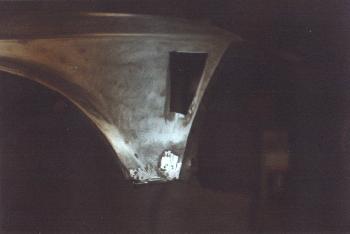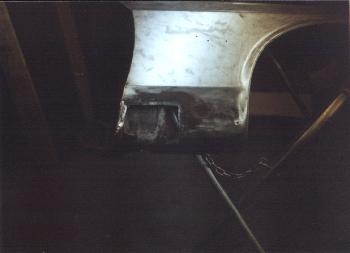 The right front fender needed some work. It had rusted through at the front and at the bottom. The fender on my parts car was too
damaged to used, but it made a good doner for patches. In this picture you see where I cut out the rust in the front. I cut out the
same section on the doner fender and butt-welded it in.
The right front fender needed some work. It had rusted through at the front and at the bottom. The fender on my parts car was too
damaged to used, but it made a good doner for patches. In this picture you see where I cut out the rust in the front. I cut out the
same section on the doner fender and butt-welded it in.
 The lower section was also cut out. It wasn't rusted all the way to the bottom. This is the only reason that I patched this fender.
With this section cut out, I sandblasted and primed the brace, which can be seen through the hole. As with the front, I cut a section off the
doner fender and butt-welded it in. Because I had a doner fender, the patches had the same shape as the pieces I cut out. After the butt-welding
process, all I had to do is grind down the welds and apply a thin coat of filler. This is just like what I did to install the rear quarter
panels. I first apply a thin coat of filler with fine fiberglass particles (This stuff is very hard, much harder then the
regular body filler. And it resists moisture). It is sanded down and then I applied a thin coat of body filler. This is mainly used to fill
in the little scratches.
The lower section was also cut out. It wasn't rusted all the way to the bottom. This is the only reason that I patched this fender.
With this section cut out, I sandblasted and primed the brace, which can be seen through the hole. As with the front, I cut a section off the
doner fender and butt-welded it in. Because I had a doner fender, the patches had the same shape as the pieces I cut out. After the butt-welding
process, all I had to do is grind down the welds and apply a thin coat of filler. This is just like what I did to install the rear quarter
panels. I first apply a thin coat of filler with fine fiberglass particles (This stuff is very hard, much harder then the
regular body filler. And it resists moisture). It is sanded down and then I applied a thin coat of body filler. This is mainly used to fill
in the little scratches.Unfortunately most of the pictures of the work I did on this fender came out too dark. I highly recommend using a digital camera when taking pictures of your project. This fender was in primer by the time I got my pictures developed.